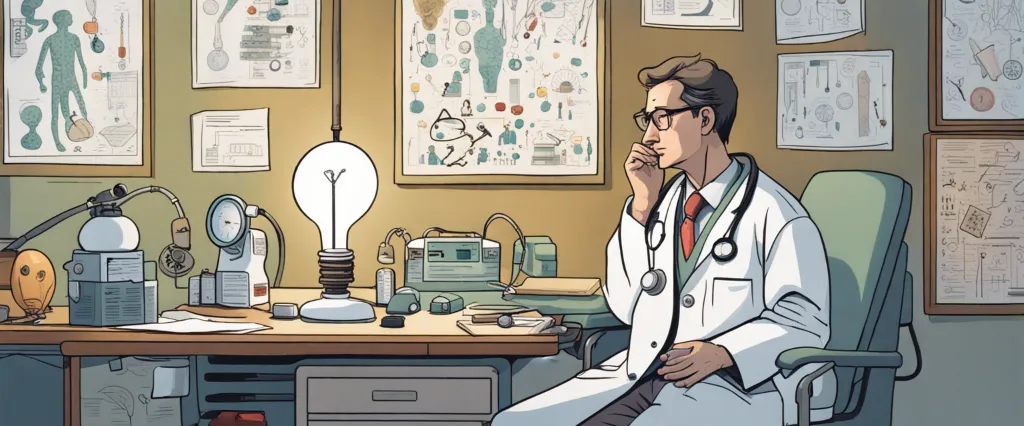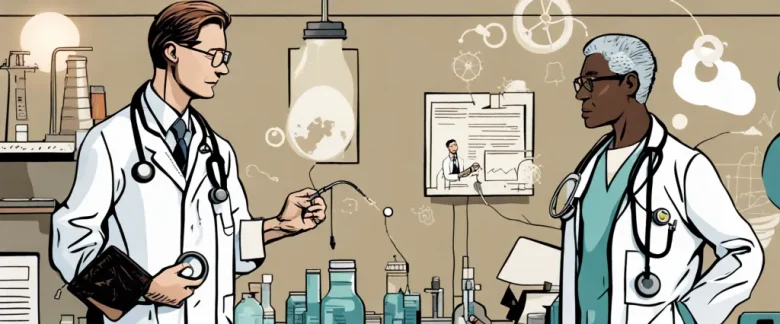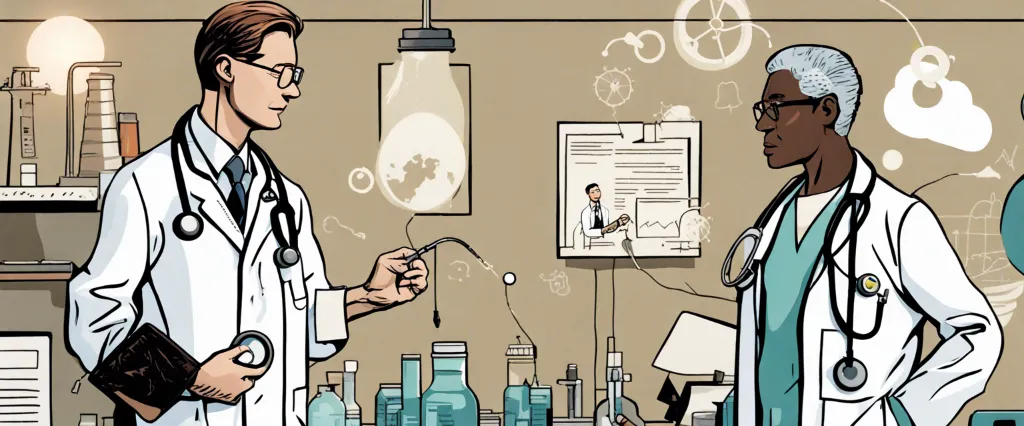In “Complications,” author Atul Gawande takes us on a riveting journey through the complex and often unpredictable world of medicine. As a practicing surgeon, Gawande brings a unique perspective to the table, blending his extensive knowledge and experience with insightful anecdotes that shed light on the many challenges doctors face every day. With a keen eye for detail, he delves into the realm of medical complications, examining the circumstances leading up to them, their impacts on patients and healthcare providers, and the important lessons they hold for improving the field. Gawande’s reputation as a successful surgeon and award-winning writer precedes him, ensuring that readers are in for a thought-provoking and enlightening exploration of the intricacies of medicine.
Chapter 1: The Uncertainty of Medicine
Chapter 1: The Uncertainty of Medicine of the book “Complications” by Atul Gawande, explores the inherent uncertainty and fallibility of medicine. The author highlights the complex nature of medical practice, which deals with unpredictable human conditions and factors that cannot always be controlled.
Gawande shares his personal experiences as a young surgical resident, encountering situations that challenge his expectations and knowledge. He describes an instance where he was called to treat a patient with severe pain in her arm, and after various tests and examinations, realized that he was unable to diagnose the cause accurately. He acknowledges that uncertainty is an integral part of medicine, and doctors often have to navigate through it to provide the best care possible.
The author presents a case of a patient named Mr. Puopolo, who underwent surgery to remove a bowel obstruction. Following the surgery, he developed sepsis, which was unexpected. Gawande conveys how the medical team strives to address the complications, but the patient’s condition deteriorates, emphasizing the complexities and uncertainties present even in seemingly routine procedures.
Gawande also discusses two surgical approaches: the traditional open surgery and the newer laparoscopic surgery, which promises faster recovery and fewer complications. However, he reveals that with the adoption of the laparoscopic method, new complications have arisen due to the lack of tactile feedback and limited vision. This unexpected development exposes the unforeseen consequences that come with advancements in medicine.
In this chapter, Gawande illustrates the inescapable uncertainty and manifold challenges that doctors face. It serves as a reminder that medicine is both an art and a science, requiring adaptability, humility, and continuous learning to navigate through the uncertainties and complexities inherent in the field.
Chapter 2: The Fallibility of Doctors
Chapter 2 of Atul Gawande’s book, “Complications,” titled “The Fallibility of Doctors,” delves into the inherent vulnerability and limitations of medical professionals. Gawande presents several real-life medical cases to emphasize that even the most skilled doctors can make mistakes and face formidable challenges.
The chapter begins with a case study of a young surgeon, named Dr. Fischer, who became overconfident due to early success and failed to identify a small leakage during a surgical procedure. This error ultimately resulted in the patient’s death. Through this example, Gawande highlights the complexity of surgery and the immense pressure faced by doctors. He discusses how the medical field rewards success and treats errors as unacceptable, which creates an environment where doctors try to hide or downplay their mistakes.
Furthermore, Gawande explores the concept of “vital signs” and how they drive medical decision-making. While vital signs like heart rate, blood pressure, and temperature are crucial in assessing a patient’s condition, they often fail to capture the full complexity of an individual case. He provides an example of a woman who experienced severe pain but was not taken seriously because her vital signs appeared normal. It turned out that she was suffering from a blocked artery, demonstrating how relying solely on vital signs can lead to misdiagnosis.
Gawande also discusses the uncertainty and ambiguity that doctors face in their practice. He explains that medical research and guidelines often offer imperfect solutions, forcing doctors to make difficult decisions based on their judgment and experience. These decisions are subjective and prone to errors, which highlights the fallibility of doctors.
In conclusion, Chapter 2 of “Complications” emphasizes that doctors are not infallible beings. They face numerous challenges, including the pressure for success, reliance on vital signs, and navigating ambiguity. By acknowledging these inherent vulnerabilities, Gawande encourages medical professionals to learn from their mistakes, embrace humility, and work towards improving patient care.
Chapter 3: The Ethics of Risk
Chapter 3: The Ethics of Risk from the book Complications by Atul Gawande examines the complex ethical dilemmas that arise in the field of medicine when patients face risks associated with their care and treatment. Gawande explores the concept of risk in medicine through various cases and scenarios, highlighting the challenges healthcare professionals face in making informed decisions while balancing patient autonomy and the desire to avoid harm.
The chapter begins by recounting the story of a young woman with a rare genetic disorder who has been experiencing multiple complications. Gawande delves into the moral struggle healthcare providers face when deciding whether to continue treatment, as there is a high risk of further complications and potentially no significant improvement in the patient’s condition. This dilemma brings up questions about the value of protecting the sanctity of life versus considering the quality of life.
Gawande also tackles the concept of informed consent and the responsibility of medical professionals to clearly communicate risks to their patients. He discusses the challenges of obtaining valid consent, especially when patients may not fully understand the risks involved or possess adequate information to make informed decisions. The chapter emphasizes the importance of ensuring patients are well-informed and actively involved in the decision-making process.
Furthermore, Gawande explores the issue of interventionalists who perform high-risk procedures, such as heart surgeries, and how they balance their duty to save lives with the inherent risks involved in such operations. He contemplates the ethical questions surrounding the necessity of taking risks to extend life or improve its quality.
In summary, Chapter 3 of Complications delves into the ethical complexities that arise when medical professionals navigate the risks associated with patient care. Gawande’s exploration of these intricacies raises thought-provoking questions about patient autonomy, informed consent, and the balance between risks and potential benefits in medical decision-making.
Chapter 4: The Cost of Care

Chapter 4: The Cost of Care of the book “Complications” by Atul Gawande dives into the complex issue of healthcare costs, specifically focusing on the experience of a patient named Lou.
Lou is a retired teacher suffering from back pain, and after undergoing extensive tests and consulting various specialists, he ultimately needs surgery. Although Lou has health insurance, he faces exorbitant out-of-pocket costs due to the deductibles and co-pays. This puts him in a difficult financial situation, where he has to make trade-offs between his medical needs and his livelihood.
Gawande highlights the profound impact of escalating healthcare costs on patients like Lou. He discusses how the medical system in the United States is designed to provide an abundance of high-tech, cost-intensive interventions, leading to rising healthcare expenditures. These costs are not only a burden on patients but also on society as a whole, ultimately affecting the accessibility and affordability of healthcare.
The author further explores the concept of value in healthcare. He emphasizes that value should not be equated with high cost or excessive procedures; instead, it should focus on achieving the best possible outcomes for patients. Gawande introduces the idea of “low-cost medicine” and shares examples of healthcare providers who prioritize value by focusing on preventive care, effective communication, and practical interventions.
Through Lou’s story, Gawande sheds light on the need for a collective responsibility in addressing healthcare costs. He argues that the medical profession, insurers, and policymakers must work together to reimagine healthcare delivery in a way that is both effective and affordable, ensuring that patients like Lou do not have to sacrifice their financial stability for their well-being.
Chapter 5: The Challenges of Innovation
Chapter 5 of the book “Complications” by Atul Gawande, titled “The Challenges of Innovation,” explores the complex and often tumultuous nature of medical innovations. Gawande begins by highlighting the case of a young girl named Durga, who was admitted to the hospital with a severe and unusual infection. Her situation presented an opportunity for the medical staff to use an innovative treatment, relying on bacteria from the environment that would typically be considered harmful. However, the team faced various challenges in implementing this pioneering treatment.
Gawande delves into the difficulties and barriers faced when trying to introduce new medical techniques. One of the primary challenges is the resistance from established medical practices that may be reluctant to change their methods. This resistance is not without reason, as innovations may have unintended consequences and unforeseen complications. Gawande discusses how the medical community often goes through a painstaking process of testing and refining before new techniques become widely accepted.
The chapter also addresses the necessity of collaboration between different specialties and teams within the medical field. Gawande illustrates how the fragmented nature of modern medicine can hinder innovation, as different departments may operate in silos without sharing critical information. He emphasizes the importance of maintaining open lines of communication and fostering a culture where ideas are shared freely and openly.
Furthermore, the author explores the role of individual personalities in the world of medical innovation. Gawande highlights that some practitioners excel at innovation, being open to experimentation and adapting quickly to new ideas. However, he cautions against the risks associated with extreme innovators who may overlook safety measures and best practices.
Overall, Chapter 5 of “Complications” explores the challenges inherent in introducing innovative medical practices while recognizing the critical need for progress in the ever-evolving field of medicine.
Chapter 6: The Human Element
Chapter 6 of the book “Complications” by Atul Gawande focuses on the importance of effective communication and teamwork in the medical field. Gawande shares stories of medical mishaps that occurred primarily due to communication breakdowns, emphasizing the significance of the human element in the practice of medicine.
Gawande starts the chapter with an anecdote about a surgical procedure gone wrong due to errors in communication between the anesthesiologist and surgeon. He then delves into various aspects of communication breakdowns in medical teams, highlighting examples such as illegible handwritten prescriptions or unclear verbal instructions.
To address these issues, Gawande explores the concept of checklists for healthcare professionals as a tool to improve communication and teamwork. He cites examples where checklists have proven to be highly effective, such as their successful implementation in reducing the rate of central line-associated bloodstream infections in hospitals.
Gawande also addresses the hierarchical structure within the medical field, where senior physicians often hold ultimate decision-making power. He argues that establishing an open and collaborative environment among medical professionals, regardless of seniority, fosters better communication and ultimately leads to improved patient outcomes.
Throughout the chapter, Gawande emphasizes that the success of any medical intervention depends not only on technical skills but also on effective teamwork and communication. By promoting an environment where professionals can openly discuss errors and learn from each other, mistakes can be minimized, and patient safety can be enhanced.
In summary, Chapter 6 of “Complications” emphasizes the crucial role of effective communication and teamwork in the practice of medicine. Gawande highlights the significance of checklists, creating an open and collaborative environment, and the need for continuous learning and improvement to provide better patient care.
Chapter 7: The Learning Curve
Chapter 7 of “Complications” by Atul Gawande, titled “The Learning Curve,” delves into the concept of mastering surgical skills through experience and the challenges that arise during this process.
Gawande starts by discussing how surgeons face a steep learning curve when acquiring new techniques or performing complex procedures. He emphasizes that the learning curve is inevitable and necessary, but it also poses serious risks to patients during the initial stages when surgeons are still honing their skills. Gawande reflects on his own experiences as a young surgeon, admitting his struggles and insecurities in coping with the learning curve.
The author introduces the example of laparoscopic cholecystectomy (gallbladder removal), a procedure that was rapidly adopted as a minimally invasive alternative to open surgery. However, initially, the complication rates were high due to surgeons’ lack of familiarity with the technique. Gawande stresses the importance of acknowledging these early complications as an unavoidable part of the learning process, as improvements can only come from learning from mistakes and gaining experience.
To overcome the learning curve challenge, Gawande highlights the significance of systematic training programs and mentorship. He discusses various methods and initiatives employed by institutions and experienced surgeons to minimize the risks faced by patients during the learning process. These include practicing on simulators, participating in surgical training courses, and mentoring relationships with more experienced surgeons.
The chapter concludes by emphasizing the need for open discussion and transparency regarding the learning curve. Gawande urges surgeons and institutions to be honest about their experiences and actively share information and data to support the advancement of surgical practice. He believes that confronting the learning curve openly can improve patient safety and ultimately help surgeons gain expertise more efficiently.
In summary, Chapter 7 of “Complications” explores the challenges posed by the learning curve in acquiring surgical skills. Gawande emphasizes the inevitability of errors and complications during the initial stages of learning and highlights the importance of training programs and mentorship to minimize patient risks. The chapter encourages transparency and open discussion to ensure continuous improvement in surgical practice.

Chapter 8: The Imperative for Change
Chapter 8: The Imperative for Change of the book “Complications” by Atul Gawande explores the necessity for change in the healthcare system. Gawande highlights the challenges and shortcomings of the current medical practices, urging for improvements to save lives and enhance patient outcomes.
The chapter begins with Gawande discussing the prevalence of medical errors and their devastating effects on patients. He recounts several case studies where errors were made, leading to serious complications or even death. These examples emphasize the urgent need for change in healthcare delivery.
Gawande then delves into the human factor in medicine, arguing that the traditional model of the all-knowing doctor is flawed. He acknowledges the complexity of medical knowledge and the difficulty of keeping up with advancements. He supports the concept of “experts” who specialize in specific aspects of medicine, acknowledging the limitations of individual physicians in managing all patients’ needs.
The author also explores how medical culture and education contribute to the resistance of change. He criticizes the hierarchical structure of medicine that often discourages open communication and collaboration. Gawande advocates for a more team-based approach to healthcare, where everyone involved, including patients, has a say and contributes to decision-making.
Furthermore, the chapter discusses the need for systematic changes to healthcare systems to ensure patient safety and quality of care. Gawande analyzes the impact of checklists, standardized procedures, and technology in reducing errors and improving outcomes. He argues that these changes should not only be focused on individual practitioners but also on the systems they work within.
In summary, Chapter 8 of “Complications” emphasizes the imperative for change in healthcare. Gawande highlights the need for a shift in medical culture, the utilization of experts, and the implementation of systematic changes to enhance patient safety and outcomes. By adopting these changes, the healthcare system can strive towards a more effective and reliable model.
After Reading
In his compelling book “Complications,” Atul Gawande offers an insightful and thought-provoking journey into the world of medicine. Through a series of powerful anecdotes and personal experiences, Gawande explores the complex nature of surgical and medical interventions, delving into the gray areas, uncertainties, and unforeseen challenges faced by healthcare professionals. Highlighting the importance of humility, continuous learning, and open communication, Gawande emphasizes that while complications are an inevitable part of medicine, they can also serve as opportunities for growth and improvement. With his exquisite storytelling and deep empathy, Gawande provides a profound understanding of the human experience in healthcare, ultimately leaving readers with a renewed appreciation for the dedication and resilience of medical professionals in their pursuit of better outcomes for patients. “Complications” is an eye-opening and indispensable read for both medical professionals and patients who seek a deeper understanding of the intricacies and nuances within the medical field.
1. “Being Mortal: Medicine and What Matters in the End” by Atul Gawande – In this powerful book, Gawande explores the flaws in end-of-life care and advocates for a more patient-centered approach that focuses on quality of life rather than medical interventions.
2. The Checklist Manifesto: How to Get Things Right” by Atul Gawande – Drawing on examples from various industries, Gawande highlights the effectiveness of simple checklists in complex situations and how they can drastically reduce errors and improve outcomes, including in healthcare.
3. When Breath Becomes Air” by Paul Kalanithi – Written by a neurosurgeon diagnosed with terminal lung cancer, this memoir reflects on life, mortality, and the intersection of medicine and spirituality, offering a compassionate perspective on the complexities of human existence.
4. “An American Sickness: How Healthcare Became Big Business and How You Can Take It Back” by Elisabeth Rosenthal – This eye-opening expose takes a critical look at the American healthcare system, revealing the profit motives driving medical practices and offering insights into how patients can navigate the system effectively.
5. “The Spirit Catches You and You Fall Down: A Hmong Child, Her American Doctors, and the Collision of Two Cultures” by Anne Fadiman – This compelling nonfiction book tells the heart-wrenching story of a Hmong girl with epilepsy, her family’s struggle to communicate with American healthcare professionals, and the clash of cultural beliefs and medical practices. It sheds light on the challenges faced by immigrant communities in navigating healthcare systems.




